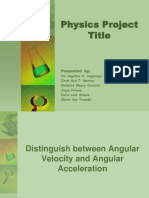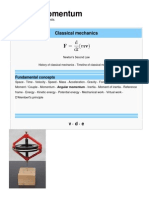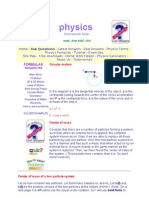Rotation: 11.1. Rotational Variables
Rotation: 11.1. Rotational Variables
Uploaded by
Jan April MahinayCopyright:
Available Formats
Rotation: 11.1. Rotational Variables
Rotation: 11.1. Rotational Variables
Uploaded by
Jan April MahinayOriginal Title
Copyright
Available Formats
Share this document
Did you find this document useful?
Is this content inappropriate?
Copyright:
Available Formats
Rotation: 11.1. Rotational Variables
Rotation: 11.1. Rotational Variables
Uploaded by
Jan April MahinayCopyright:
Available Formats
11.
ROTATION
11.1. Rotational variables
In this chapter we will be dealing with the rotation of a rigid body about a fixed axis. Every point of the body moves in a circle, whose center lies on the axis of rotation, and every point experiences the same angular displacement during a particular time interval.
Figure 11.1. Relation between s and [theta]. Suppose the z-axis of our coordinate system coincides with the axis of rotation of the rigid body. The x-axis and the y-axis are taken to be perpendicular to the z-axis. Each part of the rigid body moves in a circle around the z-axis. Suppose a given point A on the body covers a linear distance s during the rotation (see Figure 11.1). During one complete revolution point A covers a distance equal to 2[pi]r. In that case, the angle of rotation is equal to 2[pi] radians. For the situation shown in Figure 11.1, the angle of rotation can be easily calculated:
In describing the rotation of a rigid body we have to choose a reference line with respect to which the angle of rotation is being measured. In figure 11.1 the reference line connects the origin of the coordinate system and point A. The angle of rotation is the angle between the reference line and the x-axis (as is shown in Figure 11.1). If the angle of rotation [theta] is time dependent, it makes sense to introduce the concept of angular velocity and angular acceleration. The angular velocity [omega] is defined as
The unit of the angular velocity is rad/s. The angular velocity can be positive (counterclockwise rotation) or negative (clockwise rotation). The angular acceleration a is defined as
The unit of the angular acceleration is rad/s2. In order to describe rotation around a point (rather than a fixed axis) the concept of an angular velocity vector is introduced. The magnitude of the angular velocity vector is equal to the absolute value of the angular velocity for rotation around a fixed axis (as defined above). The direction of the velocity vector is parallel to the rotation axis and the right-hand rule needs to be used to determine whether the vector points upwards or downwards. Problem 7P A wheel rotates with an angular acceleration a given by
where t is the time and a and b are constants. If the wheel has an initial angular velocity [omega]0, write the equations for (a) the angular velocity and (b) the angle turned as function of time. To solve this problem, we start with looking at the relation between the angular acceleration and the angular velocity
This relation can be rewritten as
Substituting the given angular acceleration we obtain for the angular velocity
The angle of rotation is related to the angular velocity
Substituting the derived expression for [omega](t) the angle of rotation can be calculated
and therefore
11.2. Constant angular acceleration
If the angular acceleration a is constant (time independent) the following equations can be used to calculate [omega] and [theta] at any time t:
Note that these equations are very similar to the equations for linear motion. Problem 19P A wheel starting from rest, rotates with a constant angular acceleration of 2.0 rad/s2. During a certain 3.0 s interval it turns through 90 rad. (a) How long had the wheel been turning before the start of the 3.0 s interval ? (b). What was the angular velocity of the wheel at the start of the 3.0 s interval ? Time t = 0 s is defined as the moment at which the wheel is at rest. Therefore, [omega]0 = 0 rad/s. The rotation angle at any later time is measured with respect to the position of the body at time t = 0 s: [theta]0 = 0 rad. The equations of rotation are now given by
The angle of rotation during a 3.0 s interval will depend on time:
In our problem, the rotation [Delta][theta] during a period [Delta]t is given. The time that the wheel has been turning before the time period [Delta]t can be easily calculated
The angular velocity of the wheel at the beginning of this period is
11.3. Relation between linear and angular variables
An example of the relation between angular and linear variables has already been discussed. Figure 1 illustrates how the distance s, covered by point A, is related to the radius of the circle and the angle of rotation
The velocity of point A can be obtained by differentiating this equation with respect to time
To derive this equation we have assumed that for rotations around a fixed axis the distance r from point A to the rotation axis is constant (independent of time) which is true for a rigid body. The acceleration of point A can be determined as follows
The acceleration at is the tangential component of the linear acceleration, related to the change in the magnitude of the velocity of point A. However, we have seen that an object carrying out a circular motion also experiences a radial acceleration. The magnitude of the radial component, ar, is
Using the previously derived expression for v in terms of [omega] and r, we can rewrite the radial component of the acceleration as follows
Figure 11.2 shows the direction of both the radial and the tangential components of the acceleration of point A. The radial component is always present as long as [omega] is not equal to zero; the tangential component is only present if the angular acceleration is not zero.
Figure 11.2. Components of the acceleration of point A. We can conclude that when a rigid body is rotating around a fixed axis, every part of the body has the same angular velocity [omega] and the same angular acceleration a, but points that are located at different distances from the rotation axis have different linear velocities and different linear accelerations.
11.4. Kinetic energy of rotation
The total kinetic energy of a rotating object can be found by summing the kinetic energy of each individual particle:
To derive this equation we have used the fact that the angular velocity is the same for each particle of the rigid body. The quantity in parenthesis tells us how the mass of the rotating body is distributed around the axis of rotation. This quantity is called the moment of inertia (or rotational inertia)
The unit for I is kg m2. Using this definition, we can write the kinetic energy of the rotating object as
Note: in many previous problems we have assumed to be dealing with massless pulleys. This assumption assures that by applying conservation of mechanical energy we do not have to consider the kinetic energy related to the rotation of the pulley.
11.5. Calculation of rotational inertia
To calculate the moment of inertia of a rigid body we have to integrate over the whole body
If the moment of inertia about an axis that passes through the center of mass is known, the moment of inertia about any other axis, parallel to it, can be found by applying the parallel-axis theorem
where Icm is the moment of inertia about an axis passing through the center of mass, M is the total mass of the body, and h is the perpendicular distance between the two parallel axes. Sample Problem 11-8 Determine the moment of inertia of a uniform rod of mass m and length L about an axis at right angle with the rod, though its center of mass (see Figure 11.3). The mass per unit length of the rod is m/L. The mass dm of an element of the rod with length dx is
The contribution of this mass to the total moment of inertia of the rod is
The total moment of inertia of the rod can be determined by integrating over all parts of the rod:
The moment of inertia of the rod around its end point (see Figure 11.4) can now be calculated using the parallel axes theorem
Figure 11.3. Sample Problem 11-8.
Figure 11.4. Sample Problem 11.8. Example: Moment of Inertia of Disk
Figure 11.5. Moment of inertia of a disk. A uniform disk has a radius R and a total mass M. The density of the disk is given by
To calculate the moment of inertia of the whole disk, we first look at a small section of the disk (see Figure 5). The area of the ring located at a distance r from the center and having a width dr is
The mass of this ring is
The contribution of this ring to the total moment of inertia of the disk is given by
The total moment of inertia can now be found by summing over all rings:
Substituting the calculated density we obtain
You might also like
- Fire Safety Maintenance Report (FSMR) : Sinsp Ethel C MargahaDocument15 pagesFire Safety Maintenance Report (FSMR) : Sinsp Ethel C MargahaJan April Mahinay79% (24)
- Abdulai Sakina 1Document44 pagesAbdulai Sakina 1Mohammed Abu Shaibu90% (10)
- Banked Curves ReportDocument32 pagesBanked Curves Reportfrancisco bordey viernesNo ratings yet
- (Eng) Advanced Training Scaffolding 2009.0.1Document98 pages(Eng) Advanced Training Scaffolding 2009.0.1Vlad MosNo ratings yet
- Year 8 Pythagoras Theorem Practice PaperDocument3 pagesYear 8 Pythagoras Theorem Practice Paperjess_h90% (1)
- Rotational Dynamics II: Rotation About A Fixed AxisDocument11 pagesRotational Dynamics II: Rotation About A Fixed Axisrizal123No ratings yet
- Module 5Document8 pagesModule 5Benson MataNo ratings yet
- Kinematics of Rotational MotionDocument10 pagesKinematics of Rotational MotionCesska EloisseNo ratings yet
- Radius of GyrationDocument15 pagesRadius of GyrationShahid AyoubNo ratings yet
- Gen. Physics 1 Q2 Week 1.eDocument15 pagesGen. Physics 1 Q2 Week 1.eALY TVNo ratings yet
- Statics Assignment 2 PDFDocument7 pagesStatics Assignment 2 PDFDaniel RiddleNo ratings yet
- CH 15Document7 pagesCH 15akshaybj4396No ratings yet
- Rotational MechanicsDocument17 pagesRotational MechanicsAnant KumarNo ratings yet
- Experiment 103 Moment of Inertia AnalysisDocument12 pagesExperiment 103 Moment of Inertia AnalysisJerome LangitNo ratings yet
- Rotational Equilibrium and Rotational Dynamic 2Document8 pagesRotational Equilibrium and Rotational Dynamic 2Joana OlivaNo ratings yet
- Rotation of a Rigid Object About a FixedDocument67 pagesRotation of a Rigid Object About a FixedariwhathetopirhdsNo ratings yet
- Rotational Motion NotesDocument9 pagesRotational Motion NotesTvissha GoelNo ratings yet
- GeneralPhysics1 G12 Q2 Mod1 Rotational Kinematics AndRotational Dynamics Week1Document21 pagesGeneralPhysics1 G12 Q2 Mod1 Rotational Kinematics AndRotational Dynamics Week1Cristina SacayananNo ratings yet
- E103 - AgustinDocument20 pagesE103 - AgustinSeth Jarl G. AgustinNo ratings yet
- How To Calculate TorqueDocument6 pagesHow To Calculate TorqueAiza Caboles100% (1)
- Module 1 - Angular Kinematics - PER Wiki105205 PDFDocument7 pagesModule 1 - Angular Kinematics - PER Wiki105205 PDFronald salapareNo ratings yet
- Circular Motion - Wikipedia, The Free EncyclopediaDocument9 pagesCircular Motion - Wikipedia, The Free EncyclopediaAkshat TyagiNo ratings yet
- Quantum Mechanics Angular MomentumDocument13 pagesQuantum Mechanics Angular MomentumTo Get HerNo ratings yet
- Chapter 5Document18 pagesChapter 5Note Suwansomphong100% (1)
- General Physics I-9-1Document21 pagesGeneral Physics I-9-1tawhidalahi51No ratings yet
- Moment of InertiaDocument28 pagesMoment of InertiadskymaximusNo ratings yet
- Module 1Document17 pagesModule 1Kittine FormilosNo ratings yet
- Pssutc: Theme: Calculation of Moments of InertiaDocument19 pagesPssutc: Theme: Calculation of Moments of InertiaHayko SpitakciNo ratings yet
- General Physics I (finals)Document12 pagesGeneral Physics I (finals)Priyanka PinkihanNo ratings yet
- Angular MomentumDocument10 pagesAngular MomentumKlarence Medel PacerNo ratings yet
- Mechanicsssssss ExamplesDocument9 pagesMechanicsssssss ExamplesJhonrey Joey DesabilleNo ratings yet
- Angular MomentumDocument14 pagesAngular MomentumMystery777No ratings yet
- Moment of InertiaDocument16 pagesMoment of InertiaerkarnanNo ratings yet
- Kesten CH 8 10.21Document58 pagesKesten CH 8 10.21Miiss PoojaNo ratings yet
- A Gyroscope Is A Rotating Mass That Operates On The Principle ofDocument7 pagesA Gyroscope Is A Rotating Mass That Operates On The Principle ofdwijenderNo ratings yet
- The FlywheelDocument9 pagesThe FlywheelMudri MudracNo ratings yet
- Week3 Torque and Angular MomentumDocument47 pagesWeek3 Torque and Angular MomentumAndhika RKNo ratings yet
- Curvilinear TranslationDocument21 pagesCurvilinear TranslationPrime Rose CutaonNo ratings yet
- SIM!!!Document15 pagesSIM!!!Clarence Sanchez AntoninoNo ratings yet
- Ch1 Rotational MotionDocument14 pagesCh1 Rotational MotionimtiyazaligamingNo ratings yet
- Physics Project Title: Presented byDocument14 pagesPhysics Project Title: Presented byHer RiosNo ratings yet
- Moment of Inertia - WikipediaDocument108 pagesMoment of Inertia - Wikipediayan naingNo ratings yet
- Angular Displacement, Velocity, Acceleration - PacalnaDocument13 pagesAngular Displacement, Velocity, Acceleration - PacalnaAlraffy PacalnaNo ratings yet
- Unit-V Kinematics of Rigid BodyDocument38 pagesUnit-V Kinematics of Rigid BodyhiteshNo ratings yet
- Circular Motion: The RadianDocument9 pagesCircular Motion: The Radianpankaj51281No ratings yet
- Rational KinematicsDocument27 pagesRational KinematicsStephen AbadinasNo ratings yet
- Rotation of A Rigid Object: IDocument32 pagesRotation of A Rigid Object: IManuel Enrique Salas FernándezNo ratings yet
- Lab Report AnswereDocument11 pagesLab Report AnswereNaN GamingNo ratings yet
- General Physics 1.2a Rotational KinematicsDocument53 pagesGeneral Physics 1.2a Rotational KinematicsLADY SUZETTE LANDICHONo ratings yet
- Rotation Theory IIDocument21 pagesRotation Theory IIMohammed Aftab AhmedNo ratings yet
- Module 5 Planar Kinematics of A Rigid BodyDocument104 pagesModule 5 Planar Kinematics of A Rigid BodyHuy VũNo ratings yet
- Angular MomentumDocument12 pagesAngular Momentumblowmeasshole1911No ratings yet
- Rotational KinematicsDocument17 pagesRotational KinematicsBarryNo ratings yet
- Physics First YearDocument28 pagesPhysics First Yearaliraza27298No ratings yet
- Moment of InertiaDocument3 pagesMoment of InertiaRaghavendra BetakerurNo ratings yet
- Ppt-Translation & RotationDocument23 pagesPpt-Translation & RotationWang Han ZhuNo ratings yet
- Three-Dimensional Kinematics of Rigid BodiesDocument16 pagesThree-Dimensional Kinematics of Rigid BodiesTyler HocutNo ratings yet
- EP2CD4T2. PlanarMechanisms ForceTransforms MotionWRTRotatingFrames2Document41 pagesEP2CD4T2. PlanarMechanisms ForceTransforms MotionWRTRotatingFrames2Jason wonwonNo ratings yet
- Rotational Motion Engineering Mechanics IIT KanpurDocument67 pagesRotational Motion Engineering Mechanics IIT KanpurNitin SharmaNo ratings yet
- 工程力学双语Document23 pages工程力学双语hrashique8No ratings yet
- Circular MotionDocument40 pagesCircular MotionClever MurauziNo ratings yet
- Full Free Motion of Celestial Bodies Around a Central Mass - Why Do They Mostly Orbit in the Equatorial Plane?From EverandFull Free Motion of Celestial Bodies Around a Central Mass - Why Do They Mostly Orbit in the Equatorial Plane?No ratings yet
- A-level Physics Revision: Cheeky Revision ShortcutsFrom EverandA-level Physics Revision: Cheeky Revision ShortcutsRating: 3 out of 5 stars3/5 (10)
- Electrical FireDocument1 pageElectrical FireJan April MahinayNo ratings yet
- Programs and ActivitiesDocument25 pagesPrograms and ActivitiesJan April MahinayNo ratings yet
- BiologyDocument36 pagesBiologyJan April Mahinay100% (2)
- Raw Sugar ProcessingDocument6 pagesRaw Sugar ProcessingJan April MahinayNo ratings yet
- ProcessDocument3 pagesProcessJan April MahinayNo ratings yet
- Java Program To Reverse NumberDocument3 pagesJava Program To Reverse NumbervinchoooNo ratings yet
- Scheduling: Production PlanningDocument9 pagesScheduling: Production Planningashok pradhanNo ratings yet
- Solar Photo Voltaic ProductsDocument4 pagesSolar Photo Voltaic ProductshomesolarpanelsNo ratings yet
- CH 3 Robot TrajectoriesDocument31 pagesCH 3 Robot Trajectoriesessam abdallaNo ratings yet
- Cost Volume Profit PresentasiDocument89 pagesCost Volume Profit Presentasimuhammad raflyNo ratings yet
- 100+ Inequality ReasoningDocument14 pages100+ Inequality ReasoningRajnish Sharma100% (1)
- Quant Checklist 139 PDF 2022 by Aashish AroraDocument72 pagesQuant Checklist 139 PDF 2022 by Aashish AroraVAISHNAVI SHARMANo ratings yet
- Assignments of CGDocument10 pagesAssignments of CGAshok MallNo ratings yet
- MC Math 3 TrigonometryDocument14 pagesMC Math 3 TrigonometryLIBARDO, RONELYN PORIO.No ratings yet
- Steel Weight ChartDocument3 pagesSteel Weight ChartMark Superville0% (1)
- Final Exam: Introduction To AlgorithmsDocument22 pagesFinal Exam: Introduction To AlgorithmsManoj NanduriNo ratings yet
- Dispersive Bootstrap of Massive Inflation Correlators: Haoyuan Liu, Zhehan Qin, Zhong-Zhi XianyuDocument74 pagesDispersive Bootstrap of Massive Inflation Correlators: Haoyuan Liu, Zhehan Qin, Zhong-Zhi Xianyumanupd206No ratings yet
- Chapter 7. Complete Metric Spaces and Function SpacesDocument8 pagesChapter 7. Complete Metric Spaces and Function SpacesJuan David TorresNo ratings yet
- Accounting Research Center, Booth School of Business, University of ChicagoDocument14 pagesAccounting Research Center, Booth School of Business, University of Chicagodr musafirNo ratings yet
- Arc Length and Areas of SectorsDocument10 pagesArc Length and Areas of SectorsRafena MustaphaNo ratings yet
- SQQS1013 - A192 - Ga2 Ques 1 DoneDocument10 pagesSQQS1013 - A192 - Ga2 Ques 1 DoneJasmine TehNo ratings yet
- Unit 1 PPTDocument7 pagesUnit 1 PPTMAK- 47No ratings yet
- Method of Finite ElementsDocument159 pagesMethod of Finite ElementsEdgar MugaruraNo ratings yet
- Power Indicies SurdsDocument8 pagesPower Indicies SurdsHAppuuuuugsgshNo ratings yet
- Final of The Final Research Paper KOIDocument29 pagesFinal of The Final Research Paper KOIJohn Daryl SedilloNo ratings yet
- Elective 2 - Earthquake Engineering: Instructor: Engr. Crispin S. LictaoaDocument28 pagesElective 2 - Earthquake Engineering: Instructor: Engr. Crispin S. LictaoaLexi BarcelonNo ratings yet
- Cost Calculation of Construction Projects Including Sustainability Factors Using The Case Based Reasoning (CBR) MethodDocument14 pagesCost Calculation of Construction Projects Including Sustainability Factors Using The Case Based Reasoning (CBR) MethodDonna Mae MonteroNo ratings yet
- Measurement of The Internal Angles of A Loop Traverse: Lab Report AboutDocument13 pagesMeasurement of The Internal Angles of A Loop Traverse: Lab Report AboutMuhammad NuraNo ratings yet
- Quiz 2 CH 5 7 9 7.14.19Document7 pagesQuiz 2 CH 5 7 9 7.14.19Kevin NyasogoNo ratings yet
- Chapter - 4. Algebraic IdentitiesDocument44 pagesChapter - 4. Algebraic IdentitiesAnkit LadhaNo ratings yet
- Physics For Scientists and Engineers Chapter 01Document42 pagesPhysics For Scientists and Engineers Chapter 01topwarmachineNo ratings yet






























































































